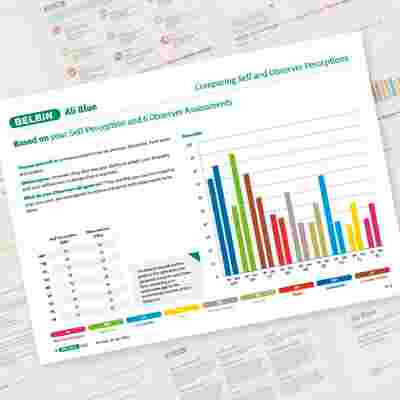The Team Roles, one by one
As the research progressed, the research revealed that the difference between success and failure for a team was not dependent on factors such as intellect, but more on behaviour.
The research team began to identify separate clusters of behaviour, each of which formed distinct team contributions or “Team Roles”.
A Belbin Team Role came to be defined as a cluster of behavioural attributes effective in facilitating team progress.
It was found that different people displayed different Team Roles to varying degrees.
The Implementer
The first Team Role to be identified was the Implementer – an organised, disciplined individual adept at planning practical strategies and working efficiently to carry them out. However, it quickly became apparent that teams made up purely of Implementers lacked creativity and flexibility.
The Plant
In an attempt to boost team performance, Dr Belbin and his team reviewed the psychometric tests they had conducted and looked for people with a creative disposition, who were good at coming up with new ideas and solving problems in unconventional ways. They 'planted’ examples of these individuals in each team, so they came to be known as ‘Plants’.
By this stage, the need for behavioural diversity in teams was becoming evident, and one by one, the other Team Roles began to emerge.
The Monitor Evaluator
The Monitor Evaluator was needed to provide a logical eye, make impartial judgements where required and to weigh up the team’s options in a dispassionate way.
The Co-ordinator
Co-ordinators were needed to focus on the team’s objectives, draw out team members and delegate work appropriately.
The Resource Investigator
When the team was at risk of becoming isolated and inwardly-focused, Resource Investigators provided inside knowledge on the opposition and made sure that the team’s idea would carry to the world outside the team.
The Completer Finisher
Completer Finishers were most effectively used at the end of a task, to “polish” and scrutinise the work for errors, subjecting it to the highest standards of quality control.
The Teamworker
Teamworkers helped the team to gel, using their versatility to identify the work required and complete it on behalf of the team.
The Shaper
Challenging individuals, known as Shapers, provided the necessary
drive to ensure that the team kept moving and did not lose focus or momentum.
Whilst some Team Roles were more “high profile” and some team members shouted more loudly than others, each of the behaviours was essential in getting the team successfully from start to finish.
Balance
The key was balance. For example, Meredith Belbin found that a team with no Plant struggled to come up with the initial spark of an idea with which to push forward. However, once too many Plants were in the team, bad ideas concealed good ones and non-starters were given too much airtime.
Similarly, with no Shaper, the team ambled along without drive and direction, missing deadlines. With too many Shapers, in-fighting began and morale suffered.
Allowable Weaknesses
As well as the strength or contribution they provided, each Team Role was also found to have an “allowable weakness”: a flipside of the behavioural characteristics, which is allowable in the team because of the strength which goes with it.
For example, the unorthodox Plant can be forgetful or struggle to communicate complex ideas.
The Resource Investigator might forget to follow up on a lead. Co-ordinators may be over-enthusiastic on the delegation front and Implementers might be slow to relinquish their plans in favour of positive changes.
Completer Finishers, often driven by anxiety to get things right, can take their perfectionism to extremes. Teamworkers, concerned with the welfare and morale of the team, find it difficult to make decisions where this morale might be compromised or where team politics is involved. Shapers risk becoming aggressive and bad humoured in their attempts to get things done.
The Specialist
It was only after the initial research had been completed, and Meredith Belbin began applying his research in industry, that the ninth Team Role of “Specialist” emerged.
The simulated management exercises had been deliberately set up to require no previous knowledge. In the real world, however, the value of an individual with in-depth knowledge of a key area came to be recognised as yet another essential team contribution or Team Role.
Just like the other Team Roles, the Specialist also had a weakness: a tendency to focus narrowly on their own subject of choice, and to prioritise this over the team’s progress.
The Team Roles that Meredith Belbin identified are used in thousands of organisations all over the world today.
Our Team Role profile
Identifying our Team Roles allows us to articulate and use our strengths to best effect, as well as being aware of our weaknesses and making efforts to mitigate them.
Most people have a number of “preferred Team Roles” or behaviours they frequently and naturally display. We also have “manageable roles” – those roles which might not come most naturally to us, but which we can assume if required, and might wish to cultivate.
Lastly, we have “least preferred” roles: those we should not assume unless absolutely necessary for the team. In this instance, the effort is likely to be great, and the outcome, poor.
Working with others
If work requires Team Roles other than our own, it is a much better bet to find and work with others who possess roles complementary to our own. Since people tend to have more than one top Team Role, a team of four could quite easily represent all nine Belbin Team Roles.
The message is that there is room for everyone in the team: all positive contributions are welcome.
In summary
So, in a nutshell, the Belbin philosophy is about celebrating – and making the most of – individual differences. The message is that there is room for everyone in the team: all positive contributions are welcome.



